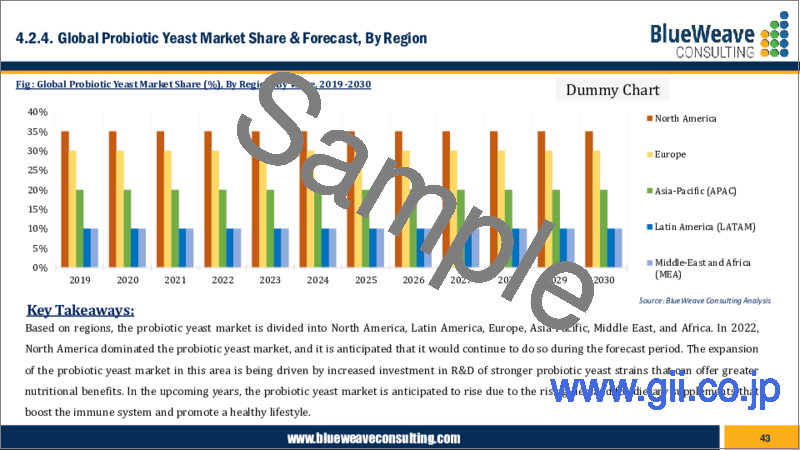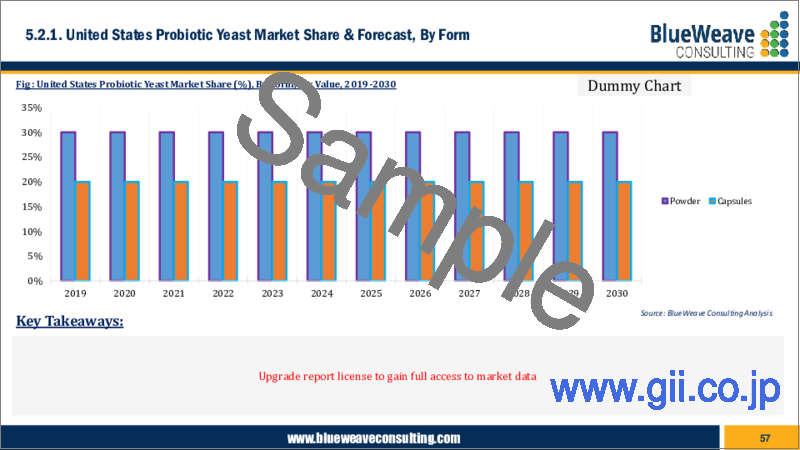|
|
市場調査レポート
商品コード
1364740
プロバイオティクス酵母市場- 世界の規模、シェア、動向分析、機会、予測レポート、2019-2029年Probiotic Yeast Market - Global Size, Share, Trend Analysis, Opportunity and Forecast Report, 2019-2029, Segmented By Form ; By Sales Channel ; By Application ; By Region |
||||||
|
|||||||
| プロバイオティクス酵母市場- 世界の規模、シェア、動向分析、機会、予測レポート、2019-2029年 |
|
出版日: 2023年10月09日
発行: Blueweave Consulting
ページ情報: 英文 400 Pages
納期: 2~3営業日
|
- 全表示
- 概要
- 目次
プロバイオティクス酵母の世界市場規模は倍増以上、2029年までに7億5,000万米ドルに達する
世界のプロバイオティクス酵母市場は、機能性食品や飲食品に対する需要の高まりと、プロバイオティクスの健康効果に対する意識の高まりにより、活況を呈しています。
戦略コンサルティングおよび市場調査の大手企業であるBlueWeave Consulting社は、最近の調査で、2022年の世界のプロバイオティック酵母市場規模を3億7,277万米ドルと推定しました。2023年から2029年の予測期間中、BlueWeaveは世界のプロバイオティック酵母市場規模が12.35%の著しいCAGRで成長し、2029年には7億4,957万米ドルに達すると予測しています。世界のプロバイオティック酵母市場の主な成長促進要因には、健康意識の高まり、予防ヘルスケアと肥満関連の健康懸念の増加傾向の管理への重点の高まりが含まれます。消費者が腸の健康を促進する機能性食品を求める中、プロバイオティック酵母は様々な食品や飲食品に入り込み、大きな人気を博しています。さらに、高齢化社会の消化器系の健康への注目、プロバイオティック酵母の潜在的な利点を強調する進行中の調査、製品の安定性を向上させる技術の進歩、戦略的提携、革新的な製品処方はすべて、市場の成長に大きく寄与しています。COVID-19の大流行も免疫衛生の重要性を浮き彫りにし、総合的な健康のためのプロバイオティック酵母への関心をさらに高めています。また、動物飼料中の抗生物質の禁止は、特に特定地域における技術革新に拍車をかけ、下痢や胃腸障害などの症状に対応するプロバイオティック酵母を組み込んだ様々な消費者製品の開発につながっています。発展途上国における可処分所得の増加と生活水準の向上は市場の成長に合致しており、有機食品とプレバイオティクスの統合を支持する新たな動向は、メーカーが異なる有効成分を組み合わせた斬新な製品を生み出し、胃腸の健康ニーズにさらに応える原動力となっています。これらの多面的な要因が、プロバイオティック酵母市場の堅調な拡大を裏付けています。しかし、プロバイオティック酵母のコストが高く、プロバイオティック製品に関する標準化された規制がないことが、予測期間中の市場全体の成長を抑制すると予想されます。
本レポートの詳細な分析により、世界のプロバイオティック酵母市場の成長可能性、今後の動向、統計に関する情報を提供します。また、総市場規模の予測を促進する要因にも焦点を当てています。当レポートは、世界のプロバイオティクス酵母市場の最新技術動向と、意思決定者が健全な戦略的意思決定を行うための業界洞察を提供することをお約束します。さらに、市場の成長促進要因・課題・競争力学についても分析しています。
目次
第1章 調査の枠組み
第2章 エグゼクティブサマリー
第3章 世界のプロバイオティクス酵母市場の洞察
- 業界のバリューチェーン分析
- DROC分析
- 成長促進要因
- 機能性食品および飲料の需要の増加
- プロバイオティクスの健康上の利点に対する意識の高まり
- 抑制要因
- プロバイオティクス酵母のコストが高い
- プロバイオティクス製品に対する標準化された規制の欠如
- 機会
- 新興国におけるプロバイオティクス市場の拡大
- 製薬およびヘルスケア分野におけるプロバイオティクスの需要の増大
- 課題
- プロバイオティクス酵母製品の安全性と有効性を確保する必要がある
- 消費者教育
- 成長促進要因
- 技術の進歩/最近の開発
- 規制の枠組み
- ポーターのファイブフォース分析
第4章 世界のプロバイオティクス酵母市場概要
- 市場規模と予測、2019~2029年
- 金額別
- 市場シェアと予測
- フォーム別
- 粉
- カプセル
- 販売チャネル別
- オンライン
- オフライン
- 用途別
- 栄養とサプリメント
- 飲食品
- 動物の飼料
- 地域別
- 北米
- 欧州
- アジア太平洋(APAC)
- ラテンアメリカ(LATAM)
- 中東およびアフリカ(MEA)
- フォーム別
第5章 北米のプロバイオティクス酵母市場
- 市場規模と予測、2019~2029年
- 金額別
- 市場シェアと予測
- フォーム別
- 販売チャネル別
- 用途別
- 国別
- 米国
- カナダ
第6章 欧州のプロバイオティクス酵母市場
- 市場規模と予測、2019~2029年
- 金額別
- 市場シェアと予測
- フォーム別
- 販売チャネル別
- 用途別
- 国別
- ドイツ
- 英国
- イタリア
- フランス
- スペイン
- ベルギー
- ロシア
- オランダ
- その他欧州
第7章 アジア太平洋のプロバイオティクス酵母市場
- 市場規模と予測、2019~2029年
- 金額別
- 市場シェアと予測
- フォーム別
- 販売チャネル別
- 用途別
- 国別
- 中国
- インド
- 日本
- 韓国
- オーストラリアとニュージーランド
- インドネシア
- マレーシア
- シンガポール
- ベトナム
- APACのその他諸国
第8章 ラテンアメリカのプロバイオティクス酵母市場
- 市場規模と予測、2019~2029年
- 金額別
- 市場シェアと予測
- フォーム別
- 販売チャネル別
- 用途別
- 国別
- ブラジル
- メキシコ
- アルゼンチン
- ペルー
- 中南米の残りの地域
第9章 中東およびアフリカのプロバイオティクス酵母市場
- 市場規模と予測、2019~2029年
- 金額別
- 市場シェアと予測
- フォーム別
- 販売チャネル別
- 用途別
- 国別
- サウジアラビア
- アラブ首長国連邦
- カタール
- クウェート
- 南アフリカ
- ナイジェリア
- アルジェリア
- MEAの残りの部分
第10章 競合情勢
- 主要企業とその製品のリスト
- 世界のプロバイオティクス酵母市場シェア分析、2022年
- 経営パラメータによる競合ベンチマーキング
- 主要な戦略的展開(合併、買収、パートナーシップなど)
第11章 世界のプロバイオティクス酵母市場に対するCOVID-19の影響
12:企業プロファイル(会社概要、財務マトリックス、競合情勢、主要人材、主要競合、連絡先住所、戦略的展望、 SWOT分析)
- Alltech
- AngelYeast Co., Ltd.
- Bronson
- Chr. Hansen Holdings A/S
- Florastor
- Jarrow Formulas
- Lallemand Inc.
- Life-Space
- Now Foods
- Seeking Health
- その他の主要企業
第13章 主要な戦略的推奨事項
第14章 調査手法
Global Probiotic Yeast Market Size More Than Doubles to Touch USD 750 Million by 2029.
Global probiotic yeast market is flourishing because of the rising demand for functional foods and beverages and increasing awareness about the health benefits of probiotics.
BlueWeave Consulting, a leading strategic consulting and market research firm, in its recent study, estimated the global probiotic yeast market size at USD 372.77 million in 2022. During the forecast period between 2023 and 2029, BlueWeave expects global probiotic yeast market size to grow at a significant CAGR of 12.35% reaching a value of USD 749.57 million by 2029. Major growth drivers for the global probiotic yeast market include increasing health awareness and a growing emphasis on preventive healthcare and the management of rising prevalence of obesity-related health concerns. As consumers seek functional foods that promote gut health, probiotic yeast has found its way into various food and beverage products, gaining significant popularity. Moreover, the aging population's focus on digestive well-being, ongoing research highlighting probiotic yeast's potential benefits, technological advancements improving product stability, strategic collaborations, and innovative product formulations have all contributed significantly to market growth. The COVID-19 pandemic has also highlighted the importance of immune health, further boosting interest in probiotic yeast for overall well-being. Also, the prohibition of antibiotics in animal feed has spurred innovation, particularly in specific regions, leading to the development of various consumer products incorporating probiotic yeast, addressing conditions like diarrhea and gastrointestinal disorders. Rising disposable incomes and improved living standards in developing nations align with market growth, while emerging trends favoring organic foods and the integration of prebiotics drive manufacturers to create novel products that combine different active ingredients, further catering to gastrointestinal health needs. These multifaceted factors collectively underscore the robust expansion of the probiotic yeast market. However, high cost of probiotic yeast and lack of standardized regulations for probiotic products are anticipated to restrain the overall market growth during the forecast period.
Global Probiotic Yeast Market - Overview:
The term "Global Probiotic Yeast Market" refers to the segment of the market dedicated to the use of microorganisms, known as probiotics, as dietary supplements aimed at enhancing overall health. Probiotic yeast specifically denotes a strain of Saccharomyces cerevisiae that is non-pathogenic, a quality highly regarded due to its natural resistance to antibacterial antibiotics. This inherent resilience makes probiotic yeast a preferred choice within the realm of probiotics. Significantly, the inclusion of probiotic yeast in animal feed has demonstrated several advantages, including improved digestibility of fiber, enhanced performance in animal production, and increased yields of meat, milk, and eggs. These benefits contribute positively to the health of the animals and, consequently, human health. Also, as per the findings of the Mysore Central Food Technology Research Institute (CFTRI), yeast-based probiotic products have found applications in reducing the toxicity associated with resilient and harmful fungi that are resistant to conventional antifungal medications. With antifungal drugs being widely used, the expanding medical use of probiotic yeast has opened up new growth opportunities within the probiotic yeast market.
Impact of COVID-19 on Global Probiotic Yeast Market
COVID-19 pandemic had a dual impact on the global probiotic yeast market. Initially, disruptions in supply chains, manufacturing, and distribution, along with a shift in consumer spending towards essential items, adversely affected the market. However, as COVID-19 emphasized the significance of bolstering the immune system, there has been a subsequent upswing in demand for immune-boosting products, including probiotic yeast. This heightened awareness and increased demand for health-related items have partially mitigated the earlier setbacks, offering a glimpse of market recovery and potential future growth. Also, the outbreak has stimulated demand for immune system enhancement products, further promoting the utilization of probiotics and positively influencing the market.
Global Probiotic Yeast Market - By Sales Channel
Based on sales channel, the global probiotic yeast market is bifurcated into Online and Offline segments. The offline segment holds a higher share in the global probiotic yeast market during the forecast period by sales channel. It can be primarily due to its well-established distribution networks encompassing retail outlets, pharmacies, and health food stores. These networks offer immediate product availability, fostering consumer trust through face-to-face interactions, personalized recommendations, and the assurance of product quality. The offline channel allows consumers to physically examine products, verify labels, and ensure product freshness, catering to those who prefer a tactile shopping experience. Also, it provides accessibility to a broader demographic, including those with limited online access or tech proficiency. This preference, combined with offline marketing efforts and brand visibility, sustains the dominance of offline sales in the probiotic yeast market.
Competitive Landscape:
Major players operating in the global probiotic yeast market include: Alltech, AngelYeast Co., Ltd, Bronson, Chr. Hansen Holdings A/S, Florastor, Jarrow Formulas, Lallemand Inc., Life-Space, Now Foods, and Seeking Health. To further enhance their market share, these companies employ various strategies, including mergers and acquisitions, partnerships, joint ventures, license agreements, and new product launches.
The in-depth analysis of the report provides information about growth potential, upcoming trends, and statistics of Global Probiotic Yeast Market. It also highlights the factors driving forecasts of total market size. The report promises to provide recent technology trends in Global Probiotic Yeast Market and industry insights to help decision-makers make sound strategic decisions. Furthermore, the report also analyzes the growth drivers, challenges, and competitive dynamics of the market.
Table of Contents
1. Research Framework
- 1.1. Research Objective
- 1.2. Product Overview
- 1.3. Market Segmentation
2. Executive Summary
3. Global Probiotic Yeast Market Insights
- 3.1. Industry Value Chain Analysis
- 3.2. DROC Analysis
- 3.2.1. Growth Drivers
- 3.2.1.1. Increasing demand for functional foods and beverages
- 3.2.1.2. Growing awareness of the health benefits of probiotics
- 3.2.2. Restraints
- 3.2.2.1. High cost of probiotic yeast
- 3.2.2.2. Lack of standardized regulations for probiotic products
- 3.2.3. Opportunities
- 3.2.3.1. Expansion of the probiotic market in emerging economies
- 3.2.3.2. Growing demand for probiotics in the pharmaceutical and healthcare sectors
- 3.2.4. Challenges
- 3.2.4.1. Need to ensure the safety and efficacy of probiotic yeast products
- 3.2.4.2. Consumer education
- 3.2.1. Growth Drivers
- 3.3. Technological Advancements/Recent Developments
- 3.4. Regulatory Framework
- 3.5. Porter's Five Forces Analysis
- 3.5.1. Bargaining Power of Suppliers
- 3.5.2. Bargaining Power of Buyers
- 3.5.3. Threat of New Entrants
- 3.5.4. Threat of Substitutes
- 3.5.5. Intensity of Rivalry
4. Global Probiotic Yeast Market Overview
- 4.1. Market Size & Forecast, 2019-2029
- 4.1.1. By Value (USD Million)
- 4.2. Market Share and Forecast
- 4.2.1. By Form
- 4.2.1.1. Powder
- 4.2.1.2. Capsules
- 4.2.2. By Sales Channel
- 4.2.2.1. Online
- 4.2.2.2. Offline
- 4.2.3. By Application
- 4.2.3.1. Nutrition and Supplement
- 4.2.3.2. Food and Beverages
- 4.2.3.3. Animal feed
- 4.2.4. By Region
- 4.2.4.1. North America
- 4.2.4.2. Europe
- 4.2.4.3. Asia Pacific (APAC)
- 4.2.4.4. Latin America (LATAM)
- 4.2.4.5. Middle East and Africa (MEA)
- 4.2.1. By Form
5. North America Probiotic Yeast Market
- 5.1. Market Size & Forecast, 2019-2029
- 5.1.1. By Value (USD Million)
- 5.2. Market Share & Forecast
- 5.2.1. By Form
- 5.2.2. By Sales Channel
- 5.2.3. By Application
- 5.2.4. By Country
- 5.2.4.1. United States
- 5.2.4.1.1. By Form
- 5.2.4.1.2. By Sales Channel
- 5.2.4.1.3. By Application
- 5.2.4.2. Canada
- 5.2.4.2.1. By Form
- 5.2.4.2.2. By Sales Channel
- 5.2.4.2.3. By Application
6. Europe Probiotic Yeast Market
- 6.1. Market Size & Forecast, 2019-2029
- 6.1.1. By Value (USD Million)
- 6.2. Market Share & Forecast
- 6.2.1. By Form
- 6.2.2. By Sales Channel
- 6.2.3. By Application
- 6.2.4. By Country
- 6.2.4.1. Germany
- 6.2.4.1.1. By Form
- 6.2.4.1.2. By Sales Channel
- 6.2.4.1.3. By Application
- 6.2.4.2. United Kingdom
- 6.2.4.2.1. By Form
- 6.2.4.2.2. By Sales Channel
- 6.2.4.2.3. By Application
- 6.2.4.3. Italy
- 6.2.4.3.1. By Form
- 6.2.4.3.2. By Sales Channel
- 6.2.4.3.3. By Application
- 6.2.4.4. France
- 6.2.4.4.1. By Form
- 6.2.4.4.2. By Sales Channel
- 6.2.4.4.3. By Application
- 6.2.4.5. Spain
- 6.2.4.5.1. By Form
- 6.2.4.5.2. By Sales Channel
- 6.2.4.5.3. By Application
- 6.2.4.6. Belgium
- 6.2.4.6.1. By Form
- 6.2.4.6.2. By Sales Channel
- 6.2.4.6.3. By Application
- 6.2.4.7. Russia
- 6.2.4.7.1. By Form
- 6.2.4.7.2. By Sales Channel
- 6.2.4.7.3. By Application
- 6.2.4.8. The Netherlands
- 6.2.4.8.1. By Form
- 6.2.4.8.2. By Sales Channel
- 6.2.4.8.3. By Application
- 6.2.4.9. Rest of Europe
- 6.2.4.9.1. By Form
- 6.2.4.9.2. By Sales Channel
- 6.2.4.9.3. By Application
7. Asia-Pacific Probiotic Yeast Market
- 7.1. Market Size & Forecast, 2019-2029
- 7.1.1. By Value (USD Million)
- 7.2. Market Share & Forecast
- 7.2.1. By Form
- 7.2.2. By Sales Channel
- 7.2.3. By Application
- 7.2.4. By Country
- 7.2.4.1. China
- 7.2.4.1.1. By Form
- 7.2.4.1.2. By Sales Channel
- 7.2.4.1.3. By Application
- 7.2.4.2. India
- 7.2.4.2.1. By Form
- 7.2.4.2.2. By Sales Channel
- 7.2.4.2.3. By Application
- 7.2.4.3. Japan
- 7.2.4.3.1. By Form
- 7.2.4.3.2. By Sales Channel
- 7.2.4.3.3. By Application
- 7.2.4.4. South Korea
- 7.2.4.4.1. By Form
- 7.2.4.4.2. By Sales Channel
- 7.2.4.4.3. By Application
- 7.2.4.5. Australia & New Zealand
- 7.2.4.5.1. By Form
- 7.2.4.5.2. By Sales Channel
- 7.2.4.5.3. By Application
- 7.2.4.6. Indonesia
- 7.2.4.6.1. By Form
- 7.2.4.6.2. By Sales Channel
- 7.2.4.6.3. By Application
- 7.2.4.7. Malaysia
- 7.2.4.7.1. By Form
- 7.2.4.7.2. By Sales Channel
- 7.2.4.7.3. By Application
- 7.2.4.8. Singapore
- 7.2.4.8.1. By Form
- 7.2.4.8.2. By Sales Channel
- 7.2.4.8.3. By Application
- 7.2.4.9. Vietnam
- 7.2.4.9.1. By Form
- 7.2.4.9.2. By Sales Channel
- 7.2.4.9.3. By Application
- 7.2.4.10. Rest of APAC
- 7.2.4.10.1. By Form
- 7.2.4.10.2. By Sales Channel
- 7.2.4.10.3. By Application
8. Latin America Probiotic Yeast Market
- 8.1. Market Size & Forecast, 2019-2029
- 8.1.1. By Value (USD Million)
- 8.2. Market Share & Forecast
- 8.2.1. By Form
- 8.2.2. By Sales Channel
- 8.2.3. By Application
- 8.2.4. By Country
- 8.2.4.1. Brazil
- 8.2.4.1.1. By Form
- 8.2.4.1.2. By Sales Channel
- 8.2.4.1.3. By Application
- 8.2.4.2. Mexico
- 8.2.4.2.1. By Form
- 8.2.4.2.2. By Sales Channel
- 8.2.4.2.3. By Application
- 8.2.4.3. Argentina
- 8.2.4.3.1. By Form
- 8.2.4.3.2. By Sales Channel
- 8.2.4.3.3. By Application
- 8.2.4.4. Peru
- 8.2.4.4.1. By Form
- 8.2.4.4.2. By Sales Channel
- 8.2.4.4.3. By Application
- 8.2.4.5. Rest of LATAM
- 8.2.4.5.1. By Form
- 8.2.4.5.2. By Sales Channel
- 8.2.4.5.3. By Application
9. Middle East & Africa Probiotic Yeast Market
- 9.1. Market Size & Forecast, 2019-2029
- 9.1.1. By Value (USD Million)
- 9.2. Market Share & Forecast
- 9.2.1. By Form
- 9.2.2. By Sales Channel
- 9.2.3. By Application
- 9.2.4. By Country
- 9.2.4.1. Saudi Arabia
- 9.2.4.1.1. By Form
- 9.2.4.1.2. By Sales Channel
- 9.2.4.1.3. By Application
- 9.2.4.2. UAE
- 9.2.4.2.1. By Form
- 9.2.4.2.2. By Sales Channel
- 9.2.4.2.3. By Application
- 9.2.4.3. Qatar
- 9.2.4.3.1. By Form
- 9.2.4.3.2. By Sales Channel
- 9.2.4.3.3. By Application
- 9.2.4.4. Kuwait
- 9.2.4.4.1. By Form
- 9.2.4.4.2. By Sales Channel
- 9.2.4.4.3. By Application
- 9.2.4.5. South Africa
- 9.2.4.5.1. By Form
- 9.2.4.5.2. By Sales Channel
- 9.2.4.5.3. By Application
- 9.2.4.6. Nigeria
- 9.2.4.6.1. By Form
- 9.2.4.6.2. By Sales Channel
- 9.2.4.6.3. By Application
- 9.2.4.7. Algeria
- 9.2.4.7.1. By Form
- 9.2.4.7.2. By Sales Channel
- 9.2.4.7.3. By Application
- 9.2.4.8. Rest of MEA
- 9.2.4.8.1. By Form
- 9.2.4.8.2. By Sales Channel
- 9.2.4.8.3. By Application
10. Competitive Landscape
- 10.1. List of Key Players and Their Offerings
- 10.2. Global Probiotic Yeast Market Share Analysis, 2022
- 10.3. Competitive Benchmarking, By Operating Parameters
- 10.4. Key Strategic Developments (Mergers, Acquisitions, Partnerships, etc.)
11. Impact of Covid-19 on Global Probiotic Yeast Market
12. Company Profile (Company Overview, Financial Matrix, Competitive Landscape, Key Personnel, Key Competitors, Contact Address, Strategic Outlook, SWOT Analysis)
- 12.1. Alltech
- 12.2. AngelYeast Co., Ltd.
- 12.3. Bronson
- 12.4. Chr. Hansen Holdings A/S
- 12.5. Florastor
- 12.6. Jarrow Formulas
- 12.7. Lallemand Inc.
- 12.8. Life-Space
- 12.9. Now Foods
- 12.10. Seeking Health
- 12.11. Other Prominent Players
13. Key Strategic Recommendations
14. Research Methodology
- 14.1. Qualitative Research
- 14.1.1. Primary & Secondary Research
- 14.2. Quantitative Research
- 14.3. Market Breakdown & Data Triangulation
- 14.3.1. Secondary Research
- 14.3.2. Primary Research
- 14.4. Breakdown of Primary Research Respondents, By Region
- 14.5. Assumptions & Limitations






